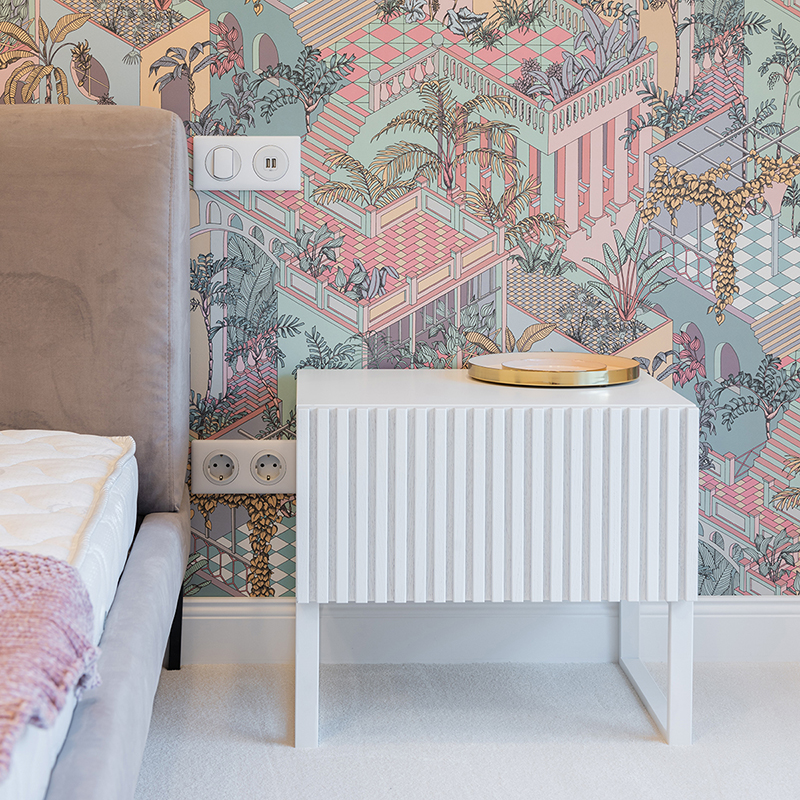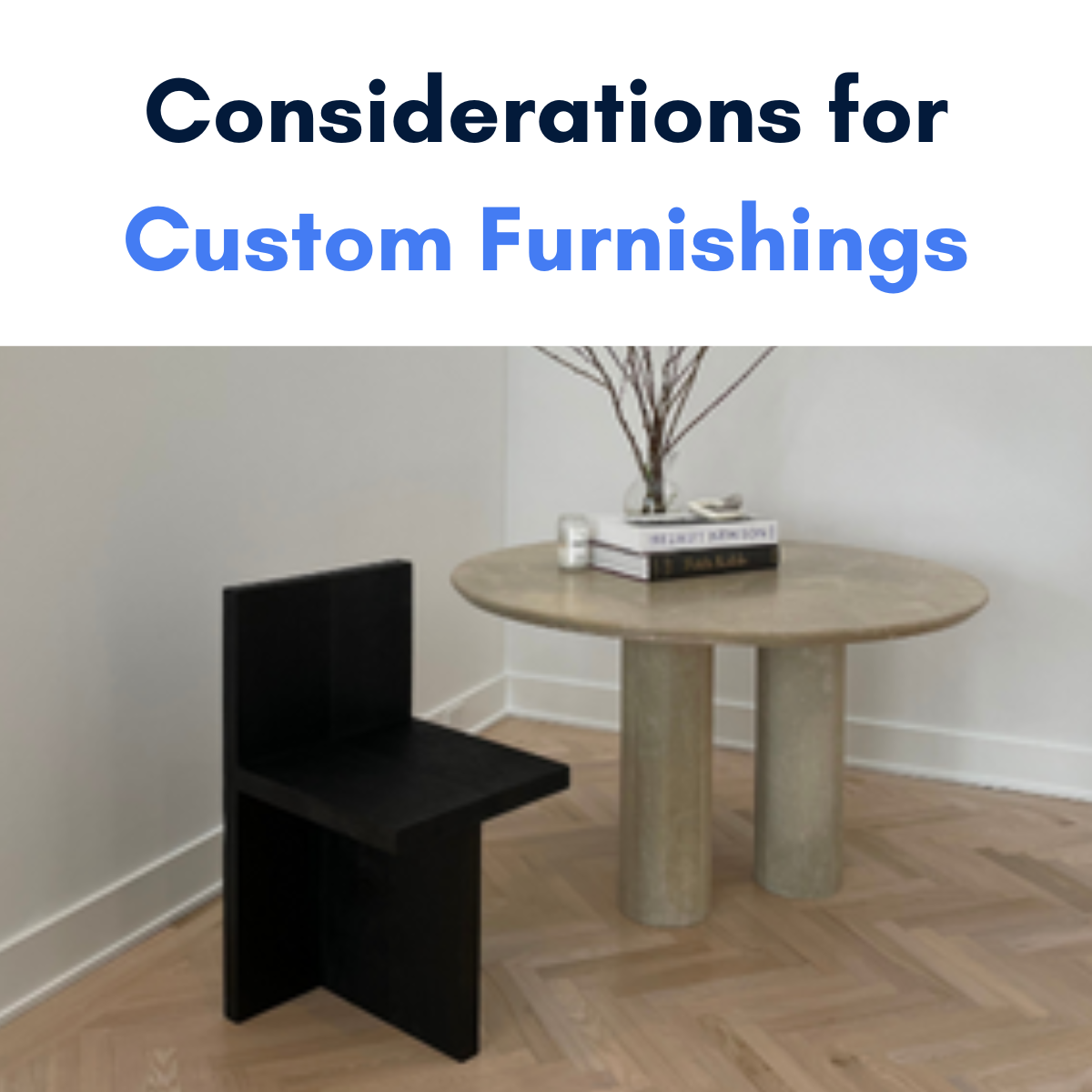In the interior design industry, it is not uncommon to come across clients who have a taste for the finer things in life. Clients who desire upscale, personalized designs are typically seeking one-of-a-kind pieces that are actually not so typical at all. As their interior designer, one solution to help them achieve their unique vision and add value to their space is to recommend custom furnishings. Custom pieces are a win for everyone in the design process, as they contribute to the distinctive look that your client is seeking, and they bring higher profitability to your business.
It is important to be aware that there is more potential for error with custom furnishings. That doesn’t mean that you should shy away from them altogether, though! Creating custom pieces simply requires an understanding of the process before diving in. Below, we have explored some of the special considerations for custom furnishings. With these tips in your toolkit, you will have the foundation you need to begin creating innovative designs that impress your clients and help you establish a signature style for your business.
Benefits For Your Business
Clients love the luxurious look that custom furnishings provide, but there are many benefits from a designer’s perspective, too. Custom products make your business stand out and give you an edge over competitors. Clients often cannot shop for custom products online themselves, which increases the demand for your services.
In addition to bringing in more work, custom products also have the potential to bring in more profitability for your business. They tend to have a higher price tag than off-the-shelf furniture and accessories because they are designed specifically for an individual. As the price of an item increases, so does your profit. This means that the more custom products you sell, the higher your profit will be. You can also use the pieces that you create for clients to build your own line of custom furnishings and further increase demand for your product offerings.
The beauty of custom is that you can have exactly what you want without having to hunt for it. Custom pieces streamline the ordering process and minimize the time spent sourcing for projects. Instead of going down a rabbit hole searching for the perfect color or size to match your concept, you can simply design the perfect color or size. It makes the ordering process much quicker and more efficient, giving you more time to focus on other aspects of the project.

The Easiest Pieces to Customize
When it comes to customization, keep in mind that no two pieces are alike. For example, drapery has a detailed set of specifications that is different from the specifications for a dining table. Fabric quantities are calculated in yards, and tile quantities are calculated in square feet. And the list goes on. All of these little nuances can make it challenging to navigate the world of custom furnishings, but there are still some pieces that are easier to customize than others. These include:
- Drapery
- Custom cut area rugs
- Nightstands/end tables
- Floating shelves
- Headboards
If you are new to custom design, we recommend starting with these types of items. They are usually less complicated to manufacture than others. Since they are often purchased in multiples, they can also help you to maximize your profitability from custom furnishings.
Details and Measurements Matter
Even with the simplest custom piece, remember that details and measurements matter more than ever. There’s nothing more frustrating and embarrassing to an interior designer than spending the time to make a custom piece for a client, only to realize that it falls short of their expectations when it finally arrives. Perhaps the piece does not fit in the space because the measurements were not accurate, or the finish is much lighter than your client expected.
There are some steps you can take to prevent surprises like this during installation. Be sure to check and double check all measurements for accuracy before the product is made. It is well worth it to spend a few extra minutes for a final check, so that you don’t have to spend hours correcting errors down the road. You should also make sure that your clients approve and sign off on every shop drawing and finish selection. This prevents you from having to shoulder the responsibility if a piece does not turn out exactly how they envisioned it.

Samples Are Essential
Another way to avoid surprises is by providing your clients with samples during the design process. Colors can look very different on a computer screen, so it is always best to obtain a physical sample that your clients can see and touch before they sign off on any materials. Keep in mind that natural materials, such as tile, stone, and wood, have some variation. You should provide clients with two samples of these materials, so that they can compare the degree of variation between them and get a better understanding of what to expect for the final product.
If the custom piece you are creating features fabric or upholstery, we recommend getting a cut for approval (CFA). A CFA is a swatch of fabric that is cut from the actual bolt of material that will be used for your order. You can use it as a reference to match a specific dye lot, so that the custom piece turns out how it was originally planned.
You should also consider investing in your own sample set for items like pillows. For example, you can create a sample set that includes one pillow with medium density fill, one with an all feather fill, and one with a combined foam and down fill. Most clients like to be able to compare their options, and they will be able to make a more informed decision if they can see and touch them before choosing their final selection.
Business Protections for Custom Purchases
While sign-off sheets and samples are helpful actions you can take to prevent surprises in the custom design process, they are not a substitute for a well-defined clause in your contract. The contract is always the safest way to protect your business from dissatisfied clients and factors that are out of your control.
Be sure to clearly note in the contract that slight variations may occur in finishes selected for custom furnishings. By establishing this upfront, your clients will have a better understanding of what to expect. You should also note that all custom pieces are final sale. Most companies have a very limited return policy, if they allow returns at all, for custom pieces. This will protect you from having to absorb the cost of an unwanted item, which could result in a loss of profit for your business.
Custom furnishings are the perfect way to personalize interior design because they allow you the freedom to modify size, color, style, or any other element to fit in seamlessly with your concept. You essentially become the manufacturer for your clients. But perhaps you are still wondering how to begin the manufacturing process for a custom piece.
The 4Dbiz Virtual Workroom is a convenient resource for designing and ordering custom furniture. When you place a custom order request through the 4Dbiz portal, you will spend less time and money on customization, while still reaping all of the rewards from a custom order. Our team understands that accuracy is crucial, and you can trust us to seamlessly handle the details for you. We can help with reviewing specifications, ordering samples, producing shop drawings, creating sign-off sheets, and placing final orders.
Our Virtual Workroom offers custom window treatments, quilting by the yard, custom bedding, table linens, pillows, cushions, bolsters, and more. Our pricing is super competitive, which means that you will enjoy a larger profit margin for your business. You can see our full price list here.
Ready to get started? Reach out to schedule an intro call and learn how to begin working with our team today!

